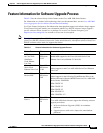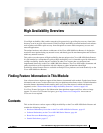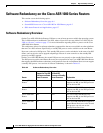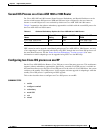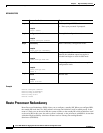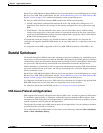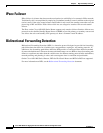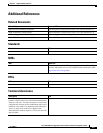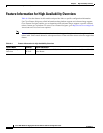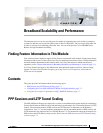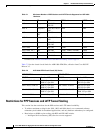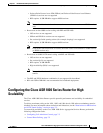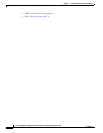
6-7
Cisco ASR 1000 Series Aggregation Services Routers Software Configuration Guide
OL-16506-17
Chapter 6 High Availability Overview
Stateful Switchover
On the Cisco ASR 1000 Series Router, RPR can also be used to enable a second IOS process on a single
RP for a Cisco ASR 1002 or 1004 Router. See the “Second IOS Process on a Cisco ASR 1002 or 1004
Router” section on page 6-5 for additional information on the second IOS process.
For the Cisco ASR 1000 Series Routers, RPR introduces the following functionality:
• Startup configuration synchronization between the active and standby RP or IOS process. It is
important to note, however, that changes in the running configuration are not synchronized using
RPR.
• Warm Reload—The Warm Reload feature allows users to reload their routers without reading
images from storage; that is, the router reboots by restoring the read-write data from a previously
saved copy in the RAM and by starting execution without either copying the software from flash to
RAM or self-decompression of the image.
It is important to note that in most cases, Stateful Switchover (SSO) requires less downtime for
switchover and upgrades than RPR. RPR should only be used when there is a compelling reason to not
use SSO.
It is important to note RPR is supported on the Cisco ASR 1000 Series Routers while RPR+ is not.
Stateful Switchover
The Stateful Switchover (SSO) feature takes advantage of processor redundancy by establishing one of
the processors as the active processor while the other RP is designated as the standby processor, and then
synchronizing critical state information between them. Following an initial synchronization between the
two processors, SSO dynamically maintains RP state information between the dual processors.
Stateful Switchover is particularly useful in conjunction with Nonstop Forwarding. SSO allows the dual
processors to maintain state at all times, and Nonstop Forwarding lets a switchover happen seamlessly
when a switchover occurs.
On the Cisco ASR 1000 Series Router, SSO can also be used to enable a second IOS process on a single
RP for a Cisco ASR 1002 or 1004 Router. See the “Second IOS Process on a Cisco ASR 1002 or 1004
Router” section on page 6-5 for additional information on the second IOS process.
It is important to note that in most cases, SSO requires less downtime for switchover and upgrades than
RPR. RPR should only be used when there is a compelling reason to not use SSO.
For additional information on NSF/SSO, see the Cisco Nonstop Forwarding document.
SSO-Aware Protocol and Applications
SSO-supported line protocols and applications must be SSO-aware. A feature or protocol is SSO-aware
if it maintains, either partially or completely, undisturbed operation through an RP switchover. State
information for SSO-aware protocols and applications is synchronized from active to standby to achieve
stateful switchover for those protocols and applications.
The dynamically created state of SSO-unaware protocols and applications is lost on switchover and must
be reinitialized and restarted on switchover.
To see which protocols are SSO-aware on your router, use the following commands show redundancy
client or show redundancy history.



